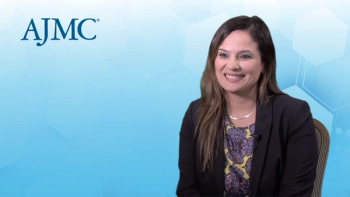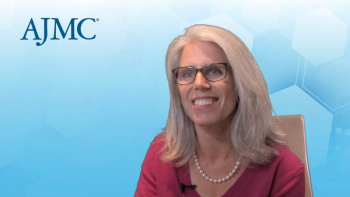
There are no FDA-approved therapies for nonalcoholic steatohepatitis (NASH), but there are many being developed. Resmetirom and obeticholic acid are both being reviewed by the FDA with decisions expected in 2023.

Laura is the vice president of content for The American Journal of Managed Care® (AJMC®) and all its brands, including Population Health, Equity & Outcomes; Evidence-Based Oncology™; and The Center for Biosimilars®. She has been working on AJMC since 2014 and has been with AJMC’s parent company, MJH Life Sciences®, since 2011.
She has an MA in business and economic reporting from New York University. You can connect with Laura on LinkedIn or Twitter.

There are no FDA-approved therapies for nonalcoholic steatohepatitis (NASH), but there are many being developed. Resmetirom and obeticholic acid are both being reviewed by the FDA with decisions expected in 2023.

Different factors have contributed to the lack of racial diversity in ophthalmology residency programs, and these programs build the future of the workforce, said Parisa Emami-Naeni, MD, MPH, assistant professor of ophthalmology at University of California, Davis, and vitreoretinal surgeon and uveitis specialist at UC Davis Eye Center.

With more and more biosimilars reaching market, there are considerations around whether to keep patients on their current biosimilar or switch them to another biosimilar as the market dictates, said Paul Forsberg, PharmD, director of pharmacy, Minnesota Oncology.

Lung cancer screening rates remain low nationwide, and there is a need to better educate patients and clinicians about the importance of screening, said Ticiana Leal, MD, associate professor, director of the Thoracic Medical Oncology Program, Department of Hematology and Medical Oncology, Emory University School of Medicine.

With multiple pathways and stakeholders involved, there needs to be an arbiter who decides what is the highest quality and highest value care in oncology, said Lucy Langer, MD, MSHS, national medical director, oncology and genomics, UnitedHealthcare.

It is an exciting time in the field of retina for emerging technologies, said Paul Hahn, MD, vitreoretinal surgeon at NJRetina.

Results from the pivotal PHOTON and PULSAR trials highlighted the success of 8-mg aflibercept every 12 or 16 weeks in patients with diabetic macular edema (DME) and neovascular age-related macular degeneration (nAMD).

The ophthalmology practice of the future will need to manage patients more efficiently and that means incorporating more technology, said Ravi Goel, MD, spokesperson for the AAO and ophthalmologist at Regional Eye Associates in New Jersey.

Targeted therapies have improved outcomes for patients with lung cancer, but the goal needs to be tailoring the right therapy to the right patient, said Ticiana Leal, MD, associate professor, director of the Thoracic Medical Oncology Program, Department of Hematology and Medical Oncology, Emory University School of Medicine.

The topline results showed the phase 3 trial met both the primary endpoint and all secondary endpoints.

There has been a sea change in how retina specialists treat retinal diseases, with a progressive shift toward more utilization of anti–vascular endothelial growth factor (VEGF), said Paul Hahn, MD, vitreoretinal surgeon at NJRetina.

Ophthalmology is image heavy, which has made the specialty amenable to telemedicine and the implementation of artificial intelligence, said Grayson Armstrong, MD, medical director, ophthalmic emergency services at Massachusetts Eye and Ear, and instructor in ophthalmology at Harvard Medical School.

The American Academy of Ophthalmology (AAO) annual meeting will present cutting-edge topics on retinal disease, as well as feature a presentation from historian Doris Kearns Goodwin, said Ravi Goel, MD, spokesperson for AAO and ophthalmologist at Regional Eye Associates in New Jersey.

When converting a patient to a biosimilar, having clear and consistent messaging will reduce confusion and prevent patients from having a lack of trust in the process, said Paul Forsberg, PharmD, director of pharmacy, Minnesota Oncology.

With 6 pegfilgrastim biosimilars approved, and multiple administration options, a patient-centric model of pegfilgrastim administration should be possible for patients with cancer who require prophylaxis of febrile neutropenia.

Teleophthalmology not only improves access to care and lowers the cost of care, but it can reduce rates of vision loss for patients with type 2 diabetes, said Parisa Emami-Naeni, MD, MPH, assistant professor of ophthalmology at University of California, Davis, and vitreoretinal surgeon and uveitis specialist at UC Davis Eye Center.

Being able to use minimal residual disease (MRD) negativity to make treatment decisions, such as stopping maintenance therapy, can have savings related to cost and quality of life (QOL) for patients, said Ajay Nooka, MD, MPH, FACP, associate professor, Winship Cancer Institute.

Patients with hepatic encephalopathy (HE) often do not seek care until they are in critical condition, making an optimized emergency care process critical to reduce adverse prognosis and improve clinical symptoms.

Biomarker testing should be done on all patients with an initial diagnosis of advanced nonsquamous non–small cell lung cancer, but the testing rates in the real world are lower than they should be, particularly for underserved or minority populations, said Ticiana Leal, MD, associate professor, director of the Thoracic Medical Oncology Program, Department of Hematology and Medical Oncology, Emory University School of Medicine.

Simply adding an admission screening question and a 2-step testing algorithm sharply decreased the number of Clostridioides difficile infections (CDI) in the year after implementing the interventions.

While commercial payers have been engaged with the shift to biosimilars, they all have their own preferred biosimilar, which makes it challenging for practices, explained Lalan Wilfong, MD, vice president of payer relations & practice transformation at The US Oncology Network.

As a result of the potential of digital therapeutics to increase access to personalized care, many choose less stringent minimal control than typically seen in randomized controlled trials (RCTs).

In 2021, the specialty drug trend rebounded from the pandemic, and it is expected to stay strong with more specialty drugs coming. Increased availability of biosimilars could shift this trend.

Different populations respond differently to drugs and treatments, but without adequate representation in clinical trials, it will be hard to judge the effectiveness of a new treatment, explained Vivienne Hau, MD, clinical assistant professor with the Kaiser Permanente Bernard J. Tyson School of Medicine.

Everyone agrees that minimal residual disease (MRD) is the best prognostic tool for multiple myeloma, but there is disagreement on how to use the MRD results, said Ajay Nooka, MD, MPH, FACP, associate professor, Winship Cancer Institute.

While initially there was a need for education around biosimilars, now there is a need to keep an eye on the evolving biosimilar marketplace and update the formulary of biosimilar medicines, said Paul Forsberg, PharmD, director of pharmacy, Minnesota Oncology.

Groups at risk for underrecognition and undertreatment of depression had improved rates of depression screening after implementing routine adult depressions screening in primary care.

Minimal residual disease (MRD) testing is used to understand the depth of response, but currently the data at Emory are not used to make treatment decisions, said Ajay Nooka, MD, MPH, FACP, associate professor, Winship Cancer Institute.

While there are a number of treatment options available for patients with chronic obstructive pulmonary disease, not all options are right for all patients.

While there are a number of treatment options available for patients with chronic obstructive pulmonary disease, not all options are right for all patients.

259 Prospect Plains Rd, Bldg H
Cranbury, NJ 08512
© 2025 MJH Life Sciences®
All rights reserved.
